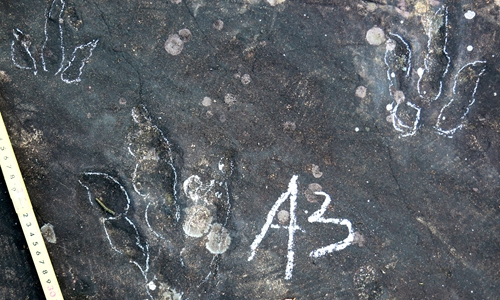HOME >> CHINA
Early Jurassic dinosaur footprints discovered in SW China
By Zhang Hui and Cao Siqi Source:Global Times Published: 2020/2/6 23:23:46

Photo: courtesy of Xing Lida
A group of international scientists led by a Chinese dinosaur expert on Friday announced the discovery of early Jurassic dinosaur footprint fossils in Hezhang county, Southwest China's Guizhou Province, which is significant for understanding the behavior, range of activity and biota composition of small and medium-sized dinosaurs in the early Jurassic period.
The footprint fossils belonged to 31 small and medium-sized theropods, nine sauropods and one anomoepus, according to a statement Xing Lida, a dinosaur expert at the Beijing-based China University of Geosciences and leader of the international team, sent to the Global Times on Friday.
A research paper on the footprints written by Xing's team was published in international scientific journal Historical Biology.
The footprint fossils were preserved in the sandstone of the Longtou Mountains in Hezhang county.
The 31 theropod footprints, each between 14 and 19 centimeters long, formed four tracks which revealed how the four dinosaurs moved. One dinosaur was trotting at a speed of 10 kilometers per hour and the other three were walking at speeds of 3.6, 4 and 6 kilometers per hour.
The majority of the 31 footprints were well preserved, with the toe pads and toes visible, and were quite similar with footprints of eubrontes in the early Cretaceous period found in Qianjiadian in Beijing, showing that the shape of the theropod footprints did not change much from the Jurassic to the early Cretaceous periods, according to the statement.
The nine sauropods footprints, with an average length of 26.8 centimeters, formed two tracks.
The discovery in Guizhou supplemented the fossil records of the early Jurassic biota in southwestern China, and is an important part of the census of the composition of the dinosaurian fauna in the region.
Posted in: SOCIETY